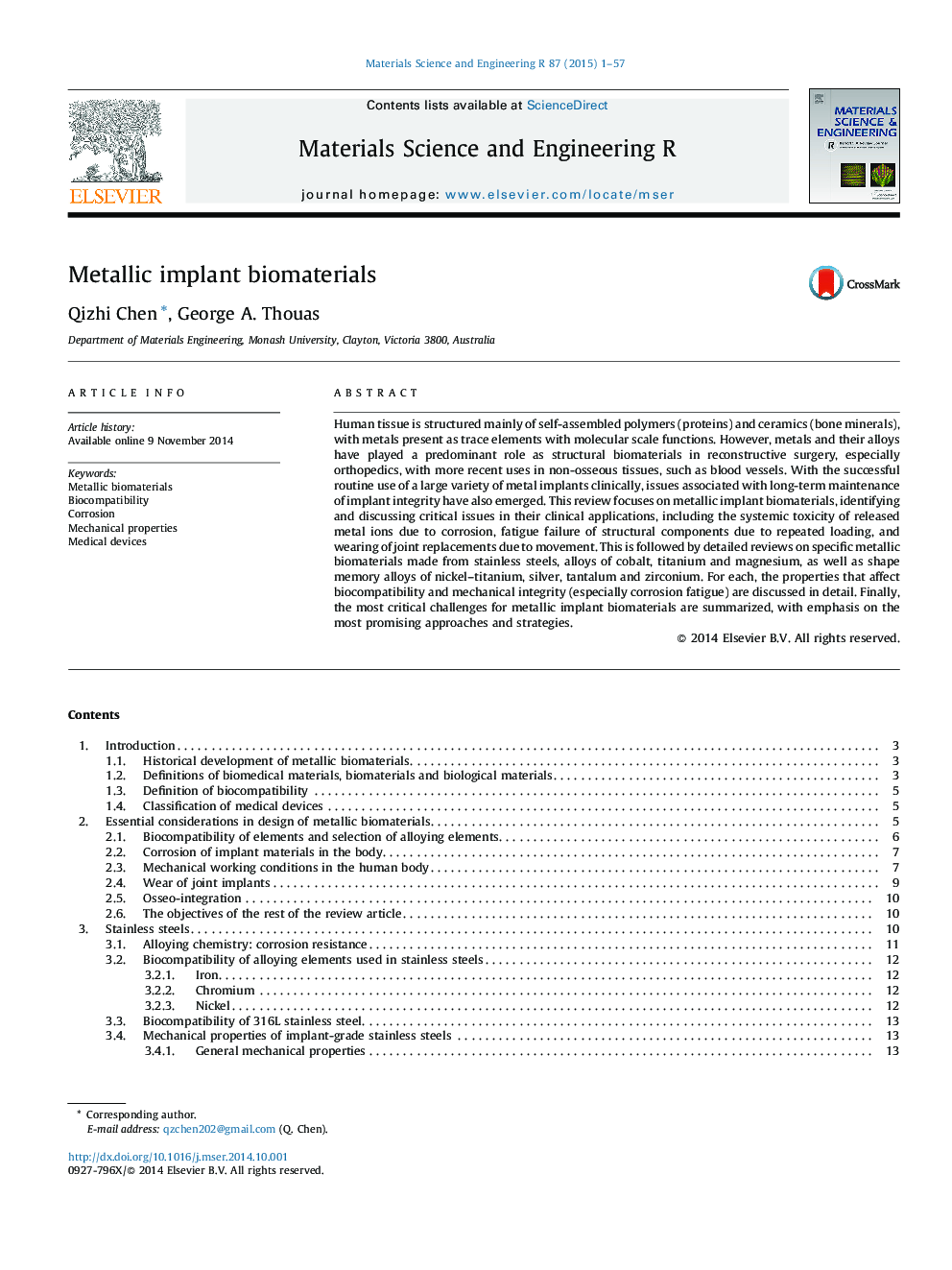| کد مقاله | کد نشریه | سال انتشار | مقاله انگلیسی | نسخه تمام متن |
|---|---|---|---|---|
| 1532359 | 1512138 | 2015 | 57 صفحه PDF | دانلود رایگان |
عنوان انگلیسی مقاله ISI
Metallic implant biomaterials
ترجمه فارسی عنوان
مواد زیستی ایمپلنت فلزی
دانلود مقاله + سفارش ترجمه
دانلود مقاله ISI انگلیسی
رایگان برای ایرانیان
کلمات کلیدی
بیومتریک های فلزی، زیست سازگاری، خوردگی، ویژگی های مکانیکی، تجهیزات پزشکی،
ترجمه چکیده
بافت انسانی عمدتا از پلیمرهای خودمختار (پروتئین) و سرامیک (کانی های استخوانی) تشکیل شده است که فلزات آن به عنوان عناصر کمیاب با توابع مقیاس مولکولی موجود است. با این حال، فلزات و آلیاژهای آنها به عنوان مواد زیستی ساختاری در جراحی ترمیمی، به ویژه ارتوپدی، نقش مهمی ایفا می کنند و با استفاده از روش های جدید در بافت های غیر پوستی نظیر عروق خونی می توان از آنها استفاده کرد. با استفاده معمول از انواع مختلفی از ایمپلنت های فلزی به طور بالقوه، مسائل مربوط به نگهداری طولانی مدت ایمنی ایمپلنت نیز ظهور کرده است. این بررسی بر روی مواد زیستی ایمپلنت فلزی متمرکز شده است، شناسایی و بحث در مورد مسائل حیاتی در برنامه های کاربردی بالینی خود، از جمله سمیت سیستمیک یون های فلز آزاد ناشی از خوردگی، شکستگی خستگی سازه های ساختاری به علت بارگیری مکرر و پوشیدن جایگزینی مفصل به علت حرکت. این به بررسی دقیق مواد زیستی خاصی از فولاد ضد زنگ، آلیاژهای کبالت، تیتانیوم و منیزیم، و نیز آلیاژهای حافظه نیکل تیتانیوم، نقره، تانتالوم و زیرکونیوم می پردازد. برای هر یک از خواص که بر سازگاری زیستی و یکپارچگی مکانیکی (به ویژه خستگی خوردگی) تاثیر می گذارد، به طور دقیق مورد بحث قرار می گیرد. در نهایت، مهم ترین چالش ها برای مواد زیستی ایمپلنت های فلزی، با تاکید بر رویکردهای و راهکارهای امیدوار کننده خلاصه می شود.
موضوعات مرتبط
مهندسی و علوم پایه
مهندسی مواد
مواد الکترونیکی، نوری و مغناطیسی
چکیده انگلیسی
Human tissue is structured mainly of self-assembled polymers (proteins) and ceramics (bone minerals), with metals present as trace elements with molecular scale functions. However, metals and their alloys have played a predominant role as structural biomaterials in reconstructive surgery, especially orthopedics, with more recent uses in non-osseous tissues, such as blood vessels. With the successful routine use of a large variety of metal implants clinically, issues associated with long-term maintenance of implant integrity have also emerged. This review focuses on metallic implant biomaterials, identifying and discussing critical issues in their clinical applications, including the systemic toxicity of released metal ions due to corrosion, fatigue failure of structural components due to repeated loading, and wearing of joint replacements due to movement. This is followed by detailed reviews on specific metallic biomaterials made from stainless steels, alloys of cobalt, titanium and magnesium, as well as shape memory alloys of nickel-titanium, silver, tantalum and zirconium. For each, the properties that affect biocompatibility and mechanical integrity (especially corrosion fatigue) are discussed in detail. Finally, the most critical challenges for metallic implant biomaterials are summarized, with emphasis on the most promising approaches and strategies.
ناشر
Database: Elsevier - ScienceDirect (ساینس دایرکت)
Journal: Materials Science and Engineering: R: Reports - Volume 87, January 2015, Pages 1-57
Journal: Materials Science and Engineering: R: Reports - Volume 87, January 2015, Pages 1-57
نویسندگان
Qizhi Chen, George A. Thouas,
